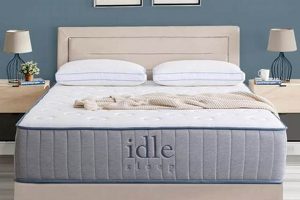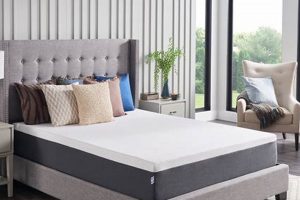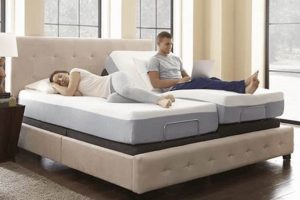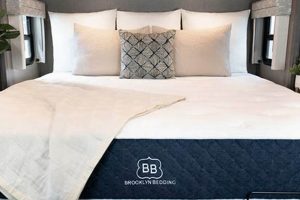The selection of an appropriate sleep surface plays a crucial role in managing discomfort and promoting spinal alignment. Sealy, a prominent mattress manufacturer, offers a range of products designed to address specific support needs. The objective is to identify a model from this manufacturer that effectively minimizes pressure points and provides optimal ergonomic support. An example would be a Sealy Posturepedic model featuring targeted lumbar reinforcement for enhanced spinal support.
The benefits of choosing a suitable mattress extend beyond mere comfort. Adequate support can contribute to improved sleep quality, reduced muscle tension, and potentially alleviate chronic back issues. Historically, advancements in sleep technology have led to the development of mattresses incorporating features such as memory foam, innerspring systems, and hybrid constructions, each aiming to provide individualized support and pressure relief.
This article will explore various Sealy mattress models, focusing on their construction, support features, and suitability for individuals experiencing back-related discomfort. We will examine key factors such as firmness levels, material composition, and targeted support zones to provide a comprehensive guide to selecting a Sealy mattress that promotes healthy spinal alignment and restful sleep.
Guidance for Selecting a Sealy Mattress
The subsequent recommendations aim to inform the decision-making process when considering a Sealy mattress for individuals experiencing back discomfort. These points emphasize factors contributing to optimal spinal alignment and pressure reduction.
Tip 1: Evaluate Firmness Level: Select a firmness level appropriate for individual body weight and sleep position. Medium-firm options generally provide balanced support and pressure relief for back sleepers. Side sleepers may benefit from slightly softer surfaces to accommodate shoulder and hip contours.
Tip 2: Consider Targeted Lumbar Support: Look for Sealy models incorporating enhanced lumbar support. These designs often feature reinforced coils or additional foam layers in the central region of the mattress to promote proper spinal alignment.
Tip 3: Assess Material Composition: Explore mattresses incorporating memory foam or latex components. These materials conform to the body’s contours, distributing weight evenly and reducing pressure points that can exacerbate discomfort.
Tip 4: Review Coil System Technology: Investigate Sealy’s coil system technology. Individually wrapped coils or specialized coil configurations can minimize motion transfer and provide enhanced support compared to traditional innerspring systems.
Tip 5: Check Edge Support: Adequate edge support is essential for preventing roll-off and maximizing the usable sleep surface. Strong edge support can also facilitate easier getting in and out of bed.
Tip 6: Inquire About Trial Periods and Warranties: Prior to purchasing, confirm the availability of a trial period to assess the mattress’s suitability. A comprehensive warranty provides assurance against manufacturing defects and premature wear.
Tip 7: Read Independent Reviews: Consult unbiased reviews from verified purchasers to gain insights into real-world performance and durability. Pay attention to comments regarding back support and comfort.
Implementing these considerations can contribute to a more informed decision, increasing the likelihood of selecting a Sealy mattress that effectively addresses back discomfort and promotes restful sleep.
The following sections will delve into specific Sealy mattress models and their features in greater detail.
1. Firmness and Support
The relationship between mattress firmness and support is paramount when addressing back discomfort. The degree of firmness directly impacts the spine’s alignment during sleep. Insufficient support can lead to spinal misalignment, exacerbating existing back conditions or even contributing to the development of new issues. Conversely, excessive firmness may create pressure points, hindering circulation and causing discomfort. The goal is to achieve a balance that supports the natural curvature of the spine while minimizing pressure concentration.
A Sealy mattress, intended for individuals experiencing back pain, must therefore offer a firmness level that corresponds to the user’s body weight, sleep position, and specific spinal condition. For example, a heavier individual may require a firmer mattress to prevent excessive sinking, which can compromise spinal alignment. A side sleeper, on the other hand, often benefits from a slightly softer surface to accommodate the shoulders and hips, maintaining a neutral spinal posture. Sealy Posturepedic models, with their emphasis on targeted support, exemplify the application of this principle.
In summary, the effectiveness of a Sealy mattress in alleviating back pain hinges on its ability to provide adequate firmness and support. This requires careful consideration of individual needs and preferences, coupled with an understanding of the interplay between firmness, spinal alignment, and pressure relief. Selecting an inappropriate firmness level can negate other beneficial mattress features, underscoring the criticality of this factor.
2. Spinal Alignment
Spinal alignment, a critical determinant of musculoskeletal health, is inextricably linked to mattress selection. A mattress failing to maintain proper spinal alignment can exacerbate existing back pain or induce new onset discomfort. The spinal column, when in its natural, neutral position, distributes weight evenly and minimizes stress on intervertebral discs, ligaments, and muscles. Deviation from this alignment, whether due to excessive sinking or inadequate support, can lead to strain and pain. A Sealy mattress marketed as a solution for back pain should therefore prioritize the maintenance of proper spinal alignment as a core functional attribute. For example, a person with scoliosis requires a mattress that accommodates and supports the curvature of their spine, preventing further misalignment and associated pain. Without this support, the user experiences increased pressure on specific areas of the spine, leading to intensified discomfort.
The practical implication of understanding this connection is reflected in the design and marketing of mattresses specifically engineered for back pain relief. Features such as targeted lumbar support, zoned coil systems, and adaptive foam layers directly address the need for customized spinal alignment. These components work synergistically to contour to the body’s unique shape, providing appropriate support where it is needed most and preventing excessive sinking in areas that require more rigid stabilization. A mattress incorporating these features, when appropriately matched to the individual’s
needs, contributes to a more restful and pain-free sleep experience.
In summary, spinal alignment constitutes a non-negotiable criterion in the selection of a Sealy mattress for back pain. The challenge lies in accurately assessing individual needs and matching them to the appropriate mattress features. Neglecting the importance of spinal alignment can negate the benefits of other comfort-enhancing features. Prioritizing proper spinal alignment is crucial for achieving the intended outcome of pain reduction and improved sleep quality.
3. Pressure Relief
Pressure relief is a primary consideration in mitigating back discomfort and a critical attribute of a mattress designed for that purpose. When the body lies on a sleep surface, pressure concentrates at points of contact, notably the shoulders, hips, and lower back. Excessive pressure restricts blood flow, triggers nerve compression, and causes discomfort. A mattress that effectively redistributes weight minimizes these concentrated pressure points, promoting improved circulation and reduced pain. Consider, for example, a person suffering from degenerative disc disease. Without adequate pressure relief, the affected spinal discs experience increased compression, leading to heightened pain and restricted movement. A mattress designed with pressure-relieving properties, such as memory foam conforming to the bodys contours, can significantly alleviate this pressure and improve sleep quality.
The practical significance of pressure relief extends beyond mere comfort. Consistent reduction of pressure points can contribute to decreased inflammation, reduced muscle tension, and improved sleep duration. Materials such as viscoelastic foam and latex are frequently employed in mattresses designed for pressure relief. These materials possess the ability to conform to the body’s shape, evenly distributing weight across the surface and minimizing localized stress. Zoned support systems, where different sections of the mattress offer varying levels of firmness, further enhance pressure relief by providing targeted support to different areas of the body. This approach prevents sinking in heavier regions, maintaining spinal alignment and reducing pressure on sensitive areas.
In summary, pressure relief is an indispensable component of a mattress intended to alleviate back pain. By minimizing concentrated pressure points, such a mattress promotes improved circulation, reduced muscle tension, and enhanced sleep quality. Selection of appropriate materials and construction techniques, such as memory foam, latex, and zoned support, are crucial for achieving effective pressure relief. Addressing pressure relief in mattress design is not simply about comfort; it is about creating an environment conducive to healing and restorative sleep, essential for managing and mitigating back-related discomfort.
4. Material Composition
The composition of materials within a mattress significantly influences its capacity to alleviate or exacerbate back discomfort. The properties of each component contribute uniquely to support, pressure relief, and overall sleep quality. Consequently, selecting a mattress for back pain necessitates a thorough examination of its constituent materials.
- Memory Foam Density and Formulation
Memory foam, a common mattress component, conforms to body contours, distributing weight and reducing pressure points. Density, measured in pounds per cubic foot, dictates firmness and durability. Higher density foam generally provides greater support and longevity. The specific formulation of the memory foam (e.g., traditional, gel-infused, open-cell) affects heat retention and breathability. Inadequate density can lead to sagging and reduced support, while poor formulation can result in overheating, both negating the intended benefits for back pain.
- Coil Type and Gauge
Innerspring mattresses rely on coils for support. The type of coil (e.g., Bonnell, pocketed, continuous) and its gauge (thickness) influence firmness and motion isolation. Pocketed coils, individually wrapped, minimize motion transfer and conform more closely to the body. Lower gauge coils (thicker wires) provide firmer support. Inadequate coil support can result in spinal misalignment and increased pressure on the lower back, exacerbating pain. Conversely, excessively firm coils without adequate cushioning can create pressure points.
- Latex Type (Natural vs. Synthetic)
Latex, derived from rubber trees (natural latex) or synthesized petroleum products (synthetic latex), offers resilient support and pressure relief. Natural latex is generally more durable, breathable, and hypoallergenic. Synthetic latex tends to be less expensive but may off-gas and degrade more quickly. The use of low-quality synthetic latex can compromise support and pressure relief, potentially contributing to back pain.
- Support Core Density and Type
The support core, often comprised of high-density foam or a coil system, provides the foundation for the mattress. Its density and type determine the overall level of support and durability. A weak or inadequate support core can lead to premature sagging and loss of support, resulting in spinal misalignment and increased back pain. A well-designed support core maintains proper spinal alignment and evenly distributes weight, contributing to long-term comfort and support.
The interplay between these materials ultimately determines the efficacy of a mattress in alleviating back pain. A mattress with high-quality components, thoughtfully combined and appropriately matched to individual needs, offers the greatest potential for providing optimal support, pressure relief, and improved sleep quality. Conversely, a mattress constructed from inferior materials or poorly designed can negate any intended benefits and potentially exacerbate existing back conditions. Therefore, meticulous attention to material composition is essential when selecting a mattress for back pain.
5. Coil Technology
Coil technology within a mattress significantly influences its ability to provide adequate support and, consequently, its effectiveness in mitigating back discomfort. The design, arrangement, and properties of coils dictate the level of contouring, motion isolation, and overall structural integrity of the sleep surface. Deficiencies in coil technology can lead to uneven support distribution, spinal misalignment, and the development of pressure points, exacerbating pre-existing back pain conditions or contributing to their onset. For instance, a traditional innerspring system with interconnected coils may exhibit excessive motion transfer, disturbing sleep and potentially aggravating back pain caused by nocturnal movements. Conversely, a system employing individually wrapped or pocketed coils can minimize motion transfer, contour independently to body shape, and provide targeted support to specific areas like the lumbar region, promoting proper spinal alignment.
Variations in coil gauge (thickness) and coil count further impact the firmness and support characteristics of a mattress. Lower gauge (thicker) coils provide greater firmness and resistance to compression, suitable
for individuals requiring substantial support. Higher coil counts, generally, result in a more responsive and contouring sleep surface. Zoned coil systems, wherein different sections of the mattress feature varying coil gauges or densities, offer tailored support to different body regions. For example, a mattress designed with firmer coils in the lumbar region and softer coils in the shoulder region can promote optimal spinal alignment for side sleepers, minimizing pressure points and reducing back pain. The specific implementation of coil technology, therefore, must be carefully considered based on individual sleep preferences, body weight, and the nature of any existing back pain conditions.
In summary, coil technology constitutes a critical component in determining the suitability of a mattress for individuals experiencing back pain. The choice of coil type, gauge, and arrangement directly impacts the level of support, contouring, and motion isolation provided. Optimizing coil technology to address individual needs and sleep preferences is essential for creating a sleep surface that promotes proper spinal alignment, reduces pressure points, and ultimately contributes to the alleviation of back discomfort. The challenges lie in accurately assessing individual requirements and selecting a mattress with coil technology that effectively addresses those needs.
6. Edge Support
Edge support, a structural feature of a mattress, plays a crucial role in its overall performance, directly influencing its suitability for individuals experiencing back pain. The perimeter of a mattress lacking adequate edge support tends to compress under pressure, leading to a sloping or sagging edge. This compromises the usable sleep surface, potentially forcing sleepers towards the center of the mattress and restricting their movement. The resulting confined sleeping position can exacerbate back pain due to restricted blood flow and uneven weight distribution.
The absence of solid edge support may create difficulties when sitting on the edge of the bed, a common activity for dressing or getting in and out of bed. This can lead to instability and increased strain on the back muscles, particularly for individuals with pre-existing conditions. A Sealy mattress designed to mitigate back pain should incorporate reinforced edge support to provide a stable and level surface across the entire mattress. This is achieved through various methods, including the use of high-density foam encasements or perimeter wire supports that bolster the edges and prevent excessive compression. Strong edge support ensures consistent support, optimizes usable sleep space, and facilitates easier and safer transitions into and out of bed.
In summary, edge support represents a fundamental design element impacting the functionality of a mattress for back pain relief. It directly influences the available sleep surface, the stability when sitting on the edge, and the overall ease of movement in and out of bed. Neglecting edge support in mattress selection can diminish its intended benefits, potentially leading to increased discomfort and reduced sleep quality. Therefore, evaluating edge support becomes a critical component when seeking a Sealy mattress as a solution for managing back pain.
7. Warranty and Trial
The warranty and trial period associated with a mattress purchase are critical factors to consider, particularly when selecting a model intended to alleviate back pain. These provisions offer assurance and opportunity to assess the mattress’s suitability for individual needs, mitigating the risk of investing in a product that fails to deliver the anticipated benefits.
- Warranty Coverage for Sagging and Defects
Mattress warranties typically cover structural defects and excessive sagging beyond a specified threshold. Sagging can compromise spinal alignment and exacerbate back pain. A comprehensive warranty provides recourse in the event that the mattress prematurely loses its support capabilities, ensuring that the investment remains protected against manufacturing flaws that could negatively impact spinal health.
- Trial Period for Comfort Assessment
Trial periods allow purchasers to test the mattress in their home environment for a designated duration. This provides a practical opportunity to evaluate comfort, support, and the potential for back pain relief. A trial period is particularly valuable, since subjective comfort and support needs are difficult to ascertain in a retail setting. The opportunity to use the mattress under realistic sleep conditions is crucial for determining long-term suitability.
- Return Policies and Associated Costs
Return policies delineate the conditions under which a mattress can be returned if it proves unsuitable. Understanding the associated costs, such as restocking fees or return shipping charges, is essential. Onerous return policies can discourage individuals from exploring alternative mattress options, even if the initial purchase fails to alleviate back pain, potentially leading to prolonged discomfort and dissatisfaction.
- Impact on Long-Term Satisfaction
The availability of a robust warranty and a generous trial period significantly impacts long-term satisfaction with a mattress purchase. These provisions provide peace of mind, knowing that the investment is protected against defects and that there is an opportunity to return the mattress if it does not meet expectations for comfort and back pain relief. Increased consumer confidence is a significant byproduct of these policies.
In conclusion, the warranty and trial period are integral components of the mattress purchasing process, particularly when seeking a solution for back pain. These provisions enable consumers to make informed decisions, assess mattress suitability under realistic conditions, and mitigate the financial risk associated with investing in a product that may not deliver the anticipated benefits. These factors contribute significantly to long-term satisfaction and the potential for improved spinal health.
Frequently Asked Questions
The following section addresses common inquiries regarding the selection and suitability of Sealy mattresses for individuals experiencing back discomfort. The information presented aims to provide clarity and assist in making informed purchasing decisions.
Question 1: Are all Sealy mattresses equally effective for back pain relief?
No. Different Sealy models incorporate varying technologies and materials, resulting in differing levels of support and pressure relief. Models specifically designated as “Posturepedic” often feature enhanced lumbar support and are generally recommended for individuals with back pain. However, individual needs and preferences remain a determining factor.
Question 2: What firmness level is generally recommended for individuals with back pain?
A medium-firm mattress is often recommended as a starting point. This firmness level typically provides a balance of support and pressure relief, accommodating various sleeping positions. However, individual body weight, sleeping position, and specific back conditions may necessitate adjustments. Consultation with a medical professional may be beneficial.
Question 3: How does memory foam contribute to back pain relief in a Sealy mattress?
Memory foam conforms to the body’s contours, distributing weight evenly and reducing pressure points. This minimizes stress on the spine and joints, potentially alleviating pain. The density and formulation of the memory foam influence its effectiveness; higher density foam generally provides greater support and durability.
Question 4: Are Sealy innerspring mattresses suitable for individuals with back pain?
Sealy innerspring mattresses can be suitable, particularly those incorporating pocketed coil systems. Pocketed coils minimize motion transfer and provide independent support, contouring to the body’s shape. The coil gauge and arrangement influence firmness; a well-designed innerspring system can provide adequate support and promote spinal alignment.
Question 5: What role does edge support play in managing back pain?
Adequate edge support prevents sagging along the perimeter of the mattress, maximizing the usable sleep surface. This ensures consistent support, even when sleeping near the edge. Strong edge support also facilitates easier and safer getting in and out of bed, minimizing strain on the back muscles.
Question 6: What should be considered regarding the warranty and trial period when purchasing a Sealy mattress for back pain?
A comprehensive warranty protects against structural defects and excessive sagging, both of which can compromise support and exacerbate back pain. A trial period allows for in-home assessment of comfort and support, providing an opportunity to return the mattress if it proves unsuitable. Understanding the terms and conditions of both the warranty and trial period is crucial.
It is important to remember that mattress selection is a highly individualized process. While these FAQs provide general guidance, personal preferences and specific medical conditions should be carefully considered. Consulting with a healthcare professional or sleep specialist may provide valuable insights.
The subsequent section will summarize the key considerations for selecting a Sealy mattress to address back-related discomfort.
Conclusion
The preceding analysis has explored various facets relevant to the selection of a Sealy mattress for individuals experiencing back-related discomfort. Key considerations encompass firmness level, spinal alignment, pressure relief, material composition, coil technology, edge support, and the implications of warranty and trial periods. Effective mitigation of back pain hinges on the careful evaluation of these factors, aligning mattress characteristics with individual needs and preferences.
The optimal selection demands a comprehensive understanding of individual spinal conditions and sleep preferences. The ultimate goal is to prioritize sleep health, consult with healthcare professionals, and rigorously assess the chosen mattress through available trial periods. By adopting this informed approach, individuals can significantly enhance their prospects for achieving restful sleep and minimizing back pain symptoms, and promote long-term spinal well-being.




![Top-Rated: Best Foam Mattress for Camping - [Year] Guide Organic & Natural Mattress Buyer’s Guide: Non-Toxic Sleep Solutions Top-Rated: Best Foam Mattress for Camping - [Year] Guide | Organic & Natural Mattress Buyer’s Guide: Non-Toxic Sleep Solutions](https://mattressworldpa.com/wp-content/uploads/2025/07/th-7661-300x200.jpg)


